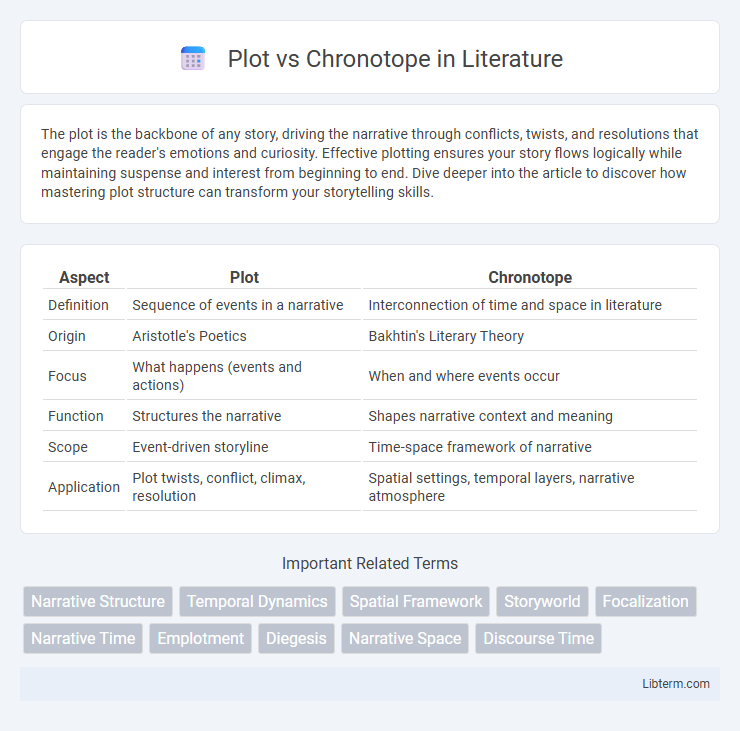The plot is the backbone of any story, driving the narrative through conflicts, twists, and resolutions that engage the reader's emotions and curiosity. Effective plotting ensures your story flows logically while maintaining suspense and interest from beginning to end. Dive deeper into the article to discover how mastering plot structure can transform your storytelling skills.
Table of Comparison
| Aspect | Plot | Chronotope |
|---|---|---|
| Definition | Sequence of events in a narrative | Interconnection of time and space in literature |
| Origin | Aristotle's Poetics | Bakhtin's Literary Theory |
| Focus | What happens (events and actions) | When and where events occur |
| Function | Structures the narrative | Shapes narrative context and meaning |
| Scope | Event-driven storyline | Time-space framework of narrative |
| Application | Plot twists, conflict, climax, resolution | Spatial settings, temporal layers, narrative atmosphere |
Understanding Plot: Definition and Elements
Plot refers to the structured sequence of events in a narrative, providing a cohesive framework that drives the story forward. Key elements of plot include exposition, rising action, climax, falling action, and resolution, each contributing to character development and thematic progression. Understanding plot involves analyzing cause-and-effect relationships and how conflicts are introduced and resolved within a specific timeframe and setting, often connected to the concept of chronotope.
Exploring Chronotope: Meaning and Significance
Chronotope, a term coined by Mikhail Bakhtin, refers to the intrinsic connectedness of temporal and spatial relationships in literature, shaping how narrative time and space interact. Unlike plot, which focuses on the sequence of events, chronotope emphasizes the setting's role in influencing character behavior, thematic development, and story dynamics. Understanding chronotope reveals deeper layers of meaning by highlighting how time and space co-construct the narrative's reality and cultural context.
Plot vs Chronotope: Key Differences
Plot centers on the sequence of events and actions driving the narrative forward, emphasizing causality and temporal progression. Chronotope integrates time and space within the narrative framework, highlighting how spatial and temporal settings shape meaning and character interactions. The key difference lies in plot's focus on event chronology versus chronotope's combined emphasis on spatial-temporal context in storytelling.
How Plot Shapes Narrative Structure
Plot structures the narrative by organizing events in a causal sequence that drives the story forward, creating coherence and meaning. It defines the temporal flow and shapes character development through conflict and resolution, distinguishing the narrative from a mere chronological recount. Unlike the chronotope, which integrates time and space as a thematic framework, plot actively constructs the story's progression and emotional impact.
The Role of Chronotope in Storytelling
The chronotope in storytelling shapes narrative structure by integrating time and space, creating a framework where events unfold coherently and meaningfully. Unlike plot, which sequences actions and causality, the chronotope contextualizes characters' experiences within specific spatial-temporal dimensions, enhancing thematic depth and emotional resonance. This spatial-temporal fusion guides readers' interpretation and anchors the story's reality, providing a rich, immersive narrative experience.
Interactions Between Plot and Chronotope
The interaction between plot and chronotope shapes narrative structure by intertwining temporal and spatial dimensions with event progression. Plot development depends on the chronotope's framework, where time and space influence character actions and conflict dynamics. The chronotope contextualizes plot elements, enabling themes to emerge through spatial-temporal settings that drive story momentum and meaning.
Historical Development of Plot in Literature
The historical development of plot in literature reveals a dynamic relationship with the concept of chronotope, which Mikhail Bakhtin defines as the intrinsic connectedness of temporal and spatial relationships in narrative. Early literary works, such as Homeric epics, structured plots primarily through linear, time-bound events emphasizing chronological progression, whereas later modernist texts incorporate complex chronotopes that challenge traditional temporal and spatial continuity. This evolution reflects shifting cultural and philosophical understandings of time and space, fundamentally transforming narrative structures and deepening thematic complexity within literary plots.
Bakhtin’s Concept of Chronotope Explained
Mikhail Bakhtin's concept of chronotope integrates time and space into a single fused phenomenon that shapes the narrative world, emphasizing how temporal and spatial relationships influence the story's structure. Unlike the plot, which focuses on the sequence of events and their causal connections, the chronotope reveals the intrinsic connection between narrative time and spatial settings, shaping character actions and thematic developments. This theoretical framework highlights how different genres employ distinct chronotopes, embedding cultural and historical contexts directly into the fabric of the narrative.
Practical Examples: Plot and Chronotope in Classic Works
In classic works like Tolstoy's *War and Peace*, the plot advances through a series of events shaped by the chronotope of the Napoleonic Wars, where historical time and specific places such as battlefields create a dynamic narrative framework. Dostoevsky's *Crime and Punishment* demonstrates the chronotope of urban St. Petersburg, merging psychological time with spatial environments that influence the plot's tension and character development. Shakespeare's *Macbeth* uses the chronotope of the Scottish castle and the supernatural night to heighten suspense, with the plot unfolding in tightly bound temporal and spatial settings that reflect inner turmoil and destiny.
Analyzing Their Impact on Reader Experience
Plot structures the sequence of events, shaping narrative tension and guiding emotional engagement, while the chronotope synchronizes time and space to create a contextual framework that deepens thematic resonance. Their interaction influences how readers perceive causality and temporal flow, enriching the interpretive complexity and immersive quality of the text. Understanding this dynamic enhances critical analysis by revealing how narrative form impacts reader empathy and meaning-making.
Plot Infographic

 libterm.com
libterm.com